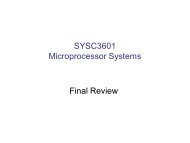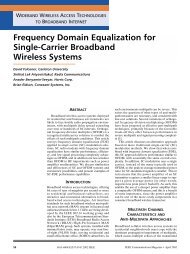Image Reconstruction for 3D Lung Imaging - Department of Systems ...
Image Reconstruction for 3D Lung Imaging - Department of Systems ...
Image Reconstruction for 3D Lung Imaging - Department of Systems ...
Create successful ePaper yourself
Turn your PDF publications into a flip-book with our unique Google optimized e-Paper software.
6. Evaluate a stopping rule. For example stopping after a single iteration [35], stopping<br />
after some fixed number <strong>of</strong> iterations, or stopping after the difference between the two<br />
sets <strong>of</strong> measurements drops below some threshold [114], i.e. ε ≤ �vmeasured − vsimulated�.<br />
If the current solution satisfies the stopping rule then exit, otherwise continue to step<br />
7.<br />
7. Update the Jacobian based on the current estimate <strong>of</strong> the conductivity. Some researchers<br />
update the Jacobian at each iteration, others do not.<br />
8. go to step 2. Note that vsimulated calculated at step 2 is a function <strong>of</strong> the iteration<br />
number, k.<br />
Equation 3.11 is similar to the difference image equation 3.7 with ˆx = ∆σ and z defined<br />
as the difference between the measured voltages and the set <strong>of</strong> simulated voltages, z =<br />
vmeasured − vsimulated. Although the interpretation <strong>of</strong> x and z are different the Jacobian is<br />
the same as those used <strong>for</strong> difference imaging. Often the regularization matrices are also<br />
the same as those used in difference imaging.<br />
3.3.1 MAP Regularized Inverse<br />
The most clearly <strong>for</strong>mulated reconstruction model <strong>for</strong> 2D difference imaging at the start <strong>of</strong><br />
this work was the Maximum a Posteriori (MAP) algorithm <strong>of</strong> Adler and Guardo [4]. The<br />
MAP approach to image reconstruction defines the solution as the most likely estimate <strong>of</strong><br />
ˆx given the measured signal z and certain statistical in<strong>for</strong>mation about the medium. This<br />
approach allows an elegant interpretation <strong>of</strong> the image reconstruction algorithm in terms <strong>of</strong><br />
statistical properties <strong>of</strong> the experimental situation. It is explained in the following section.<br />
In order to simplify the reconstruction algorithm the image statistical properties are<br />
modeled by a Gaussian distribution <strong>of</strong> mean x∞ and covariance Rx<br />
x∞ = E [x]<br />
Rx = E [x − x∞] = E � x T x � − x T ∞ x∞<br />
With these parameters the distribution function <strong>of</strong> the image, f(x), is modeled as<br />
f(x) =<br />
1<br />
(2π) N/2 � |Rx| e−(1/2)(x−x∞)T R −1<br />
x (x−x∞)<br />
(3.14)<br />
(3.15)<br />
The a posteriori distribution function <strong>of</strong> z given a conductivity distribution x is derived<br />
from the definition <strong>of</strong> the inverse problem, equation 3.1:<br />
f(z|x) =<br />
1<br />
(2π) M/2 � |Rn| e−(1/2)(z−Hx)T R −1<br />
n (z−Hx)<br />
(3.16)<br />
The difference (z − Hx) is due entirely to the noise n, which is assumed to be Gaussian,<br />
white, zero mean with covariance Rn. Thus<br />
⎡<br />
⎤<br />
Rn = E � n T n � ⎢<br />
= ⎢<br />
⎣<br />
σ2 1 0 · · · 0<br />
0 σ2 2 0<br />
.<br />
. ..<br />
0 0 · · · σ 2 M<br />
.<br />
⎥<br />
⎦<br />
(3.17)<br />
where σ in this and all subsequent equations in this section, represents the square root <strong>of</strong><br />
the variance and not the conductivity.<br />
40





